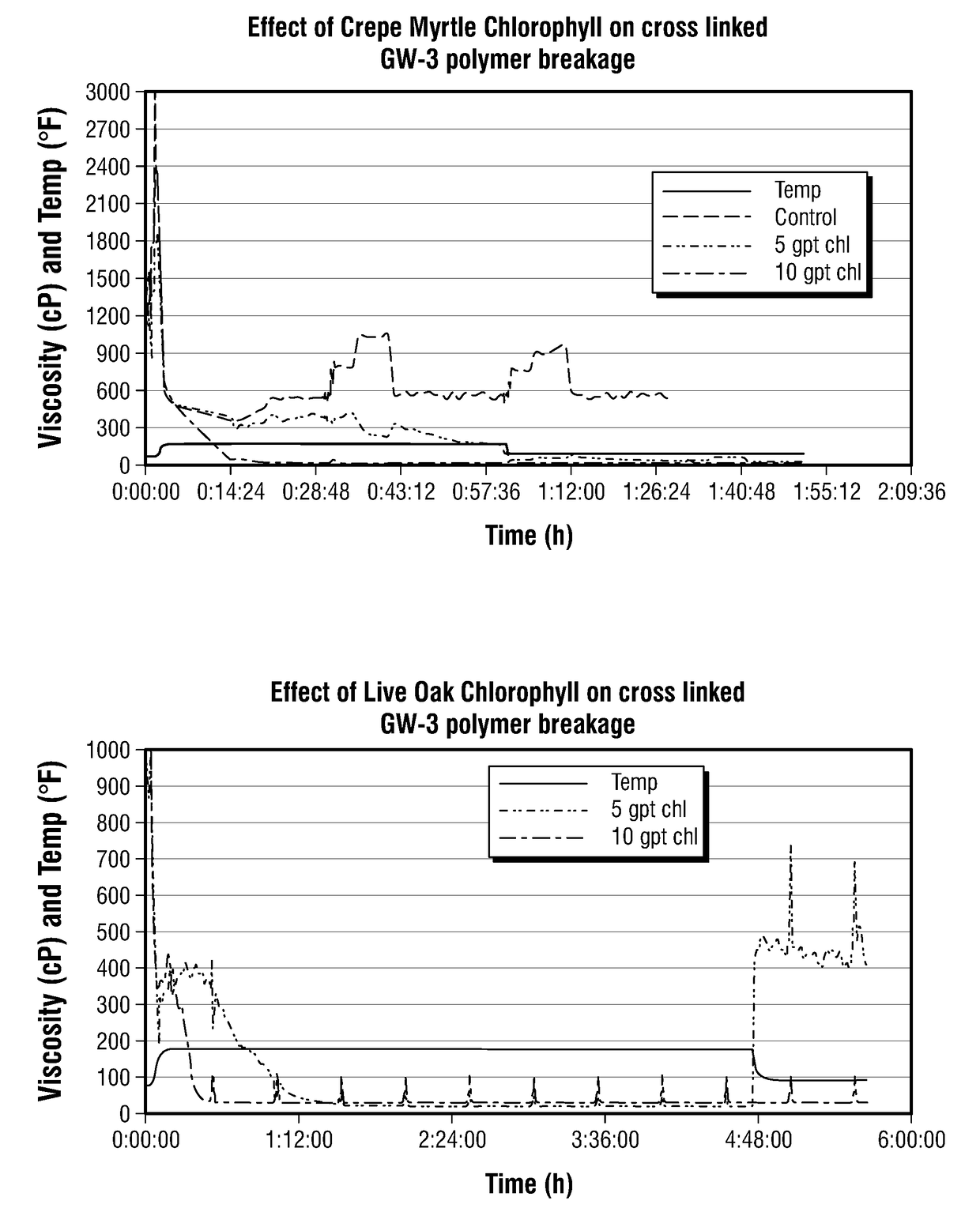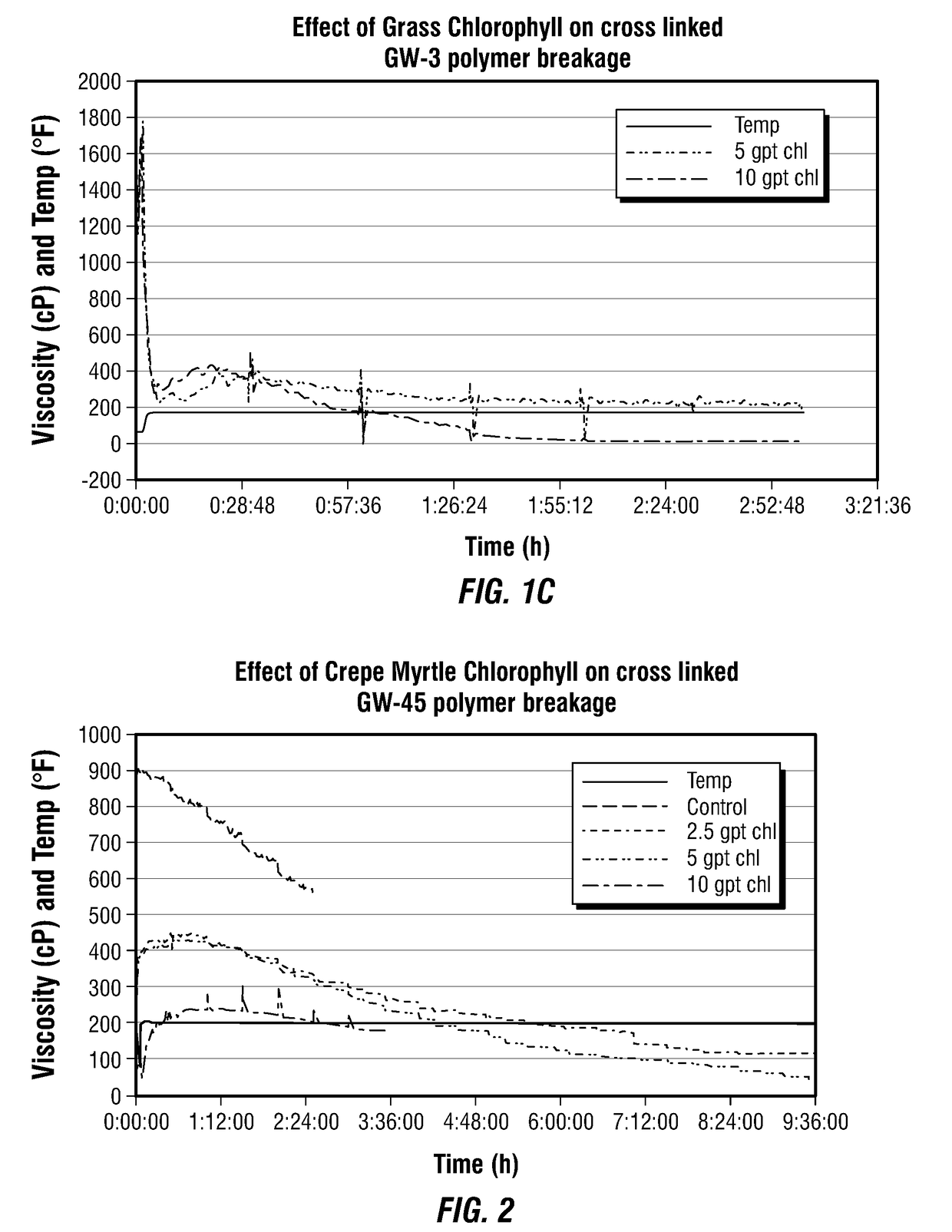Hydrocarbon Well Treatment Methods and Fluids
a technology of hydrocarbon wells and treatment methods, applied in the direction of drilling compositions, chemistry apparatus and processes, etc., can solve the problems that the fluids that can be operated at ambient temperature at the surface generally do not exhibit a sufficiently high viscosity to transfer proppant of a large size or large quantity, and achieve the effect of reducing the first viscosity of the fluid
- Summary
- Abstract
- Description
- Claims
- Application Information
AI Technical Summary
Benefits of technology
Problems solved by technology
Method used
Image
Examples
example 1
[0035]FIGS. 1A, 1B, and 1C show the effect of crepe myrtle (1A), live oak (1B), and St. Augustine grass (1C) chlorophyll extract in the breakage of cross-linked GW-3LDF guar polymer at a pH of 9.5. Results showed concentration dependent breakage of cross-linked guar polymer indicating slower breakage with 5 gpt and faster breakage with 10 gpt of 10% wt. / vol. chlorophyll extract. Reduction in temperature after conducting reactions at 175° F. showed that the polymer regained its viscosity when 5 gpt chlorophyll was used. However, 10 gpt chlorophyll completely broke the polymer and no regain in fluid viscosity was observed. In the case of grass chlorophyll, the reduction in temperature after conducting reactions at 175° F. showed that the polymer regained its viscosity when 5 gpt or 10 gpt chlorophyll was used as breaker.
example 2
[0036]FIG. 2 shows the effect of crepe myrtle chlorophyll extract on the breakage of cross-linked GW-45 CMG polymer. Results showed concentration dependent breakage of cross-linked CMG polymer indicating slower breakage with 2.5 gpt (0.5 mL) and faster breakage with 5 gpt (1 mL) of 10% wt. / vol. chlorophyll extract. Reduction in temperature after conducting reactions at 200° F. showed that the polymer had a slight regain in viscosity with 2.5 gpt chlorophyll, but almost no regain was seen with 5 gpt and 10 gpt.
example 3
[0037]FIG. 3A shows the effect of 10% wt. / vol. crepe myrtle chlorophyll extract on the breakage of linear GW-3LDF guar and GW-45 CMG polymers at 175 or 150° F. Both OFITE (bar diagrams) and densitometer intrinsic viscosity (Table 3) measurements were performed. FIG. 3B shows the effect of 10% wt. / vol. crepe myrtle chlorophyll extract on the breakage of cross-linked GW-3LDF guar polymer at a pH of 9.5 and 175° F. OFITE measurements were performed. Results showed concentration dependent breakage indicating partial viscosity reduction with 5 gpt chlorophyll and complete viscosity reduction with 10 gpt chlorophyll.
TABLE 3Molecular Weight Changes (Intrinsic Viscosity)GW-45 CMGGW-3LDFGW-3LDF guarBreakerlinearguar linearlinearControl3,042,0001,472,312indeterminate 5 gpt180,496194,133184,57610 gpt4,780137,7843601
PUM
| Property | Measurement | Unit |
|---|---|---|
| concentration | aaaaa | aaaaa |
| viscosity | aaaaa | aaaaa |
| pressure | aaaaa | aaaaa |
Abstract
Description
Claims
Application Information
 Login to View More
Login to View More - R&D
- Intellectual Property
- Life Sciences
- Materials
- Tech Scout
- Unparalleled Data Quality
- Higher Quality Content
- 60% Fewer Hallucinations
Browse by: Latest US Patents, China's latest patents, Technical Efficacy Thesaurus, Application Domain, Technology Topic, Popular Technical Reports.
© 2025 PatSnap. All rights reserved.Legal|Privacy policy|Modern Slavery Act Transparency Statement|Sitemap|About US| Contact US: help@patsnap.com



